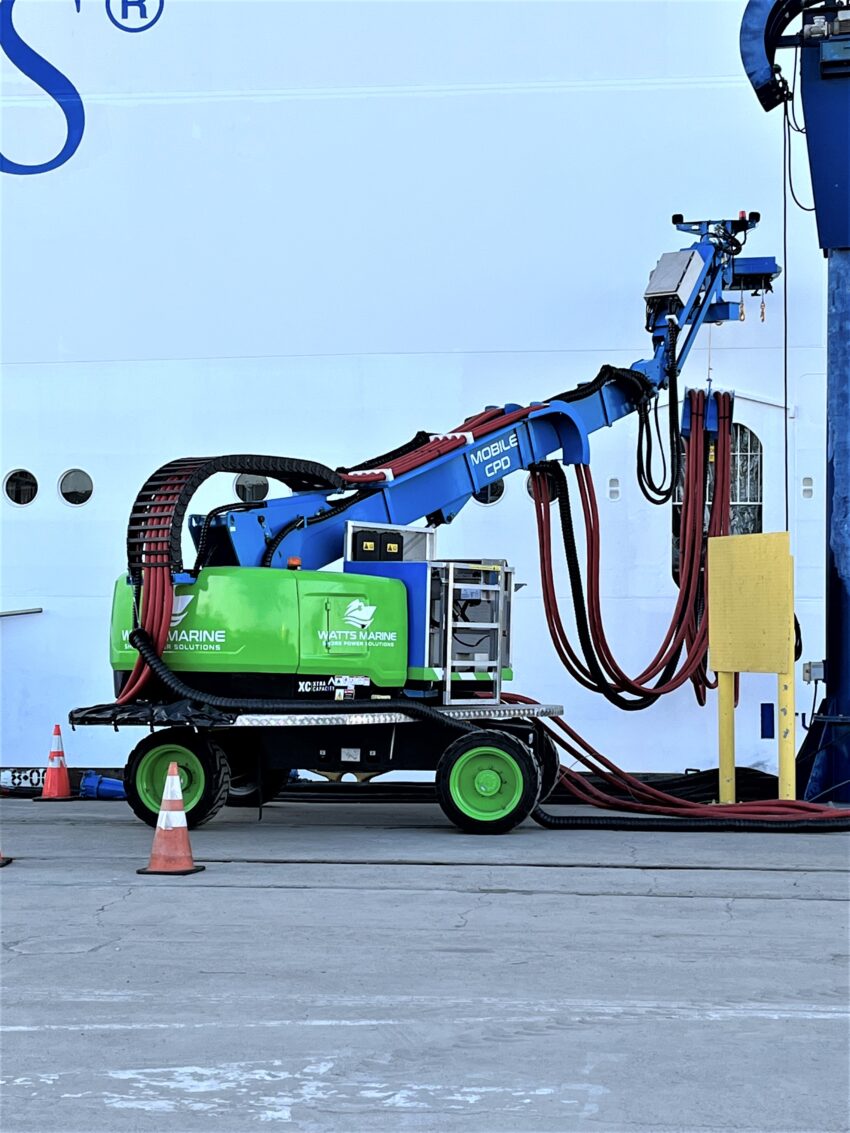Mobile Cable Positioning Devices can quickly accommodate vessels of many sizes and shapes, making shore power available almost immediately, a boon to the industry’s ambitious decarbonization goals
One of the keys to reaching Cruise Lines International Association’s (CLIA) target of net-zero carbon cruising globally by 2050 is switching from diesel burning engines to shoreside electricity while in port. Although the technology can significantly reduce emissions to address climate change and improve air quality, one impediment to adoption has been the challenge of efficiently connecting ships of various sizes and shapes to shore power with cabling and equipment on piers.
Although fixed systems exist for vessels to connect to shoreside electricity in port, the options are complex, expensive, and occupy valuable pier real estate. Repositioning a fixed system to accommodate vessels of different sizes and configurations can take several days.
Now an innovative, cost-effective Mobile Cable Positioning Device (CPD) is facilitating shore power connections by moving the cabling strategically to the ideal location. The first unit has already been delivered for use at the Port of San Diego, California.
“The Mobile CPD is a mobile manlift on a turret that rotates 360 degrees that we retrofitted from a Genie lift into an electrified cable positioning device,” explains Mike Watts, president, and founder of Kingston, WA-based Watts Marine, an innovator and integrator of shore power technology systems that developed the Mobile CPD in cooperation with European partner companies, Hybeko and IGUS.
Watts Marine has installed Shore Power System at ports in Seattle, San Diego, San Francisco, Halifax, Vancouver BC, Brooklyn, and Long Beach. The company delivers shore power systems to large marine vessels such as cruise ships, tugs, and ferries, and currently operates 10 of the 12 systems in North America. Today, approximately 500 ships a year connect to the company’s shoreside electrical power equipment.
The company covers every step of the shore power process, from helping the marine industry navigate the fine points of regulatory advising through design, build, heavy equipment installation, and system operation and maintenance. The company’s shore power system consists of proprietary equipment developed specifically to serve the cruise ship industry. This includes equipment for dual-voltage electrical service, custom-developed electrical cable handling, and electronic monitoring and control.
In 2009, Watts Marine developed a “fixed” CPD with a small footprint that provided some flexibility in supplying shoreside electricity. The new mobile design, however, simplifies moving the system to accommodate docked vessels of all sizes and configurations. The mobile cable positioning device can be used with any shoreside electric power systems, not just Watts Marine installations.
“What the industry needed was a mobile device that can be strategically positioned where the ship is docked and can then be moved to support another ship, say, 60 feet away,” says Watts. Obviously, with a fixed system that is not possible, and it can take days to move it if that is required.”
The unit is designed to allow the operator to strategically position the Mobile CPD, then plug into shore power cables on the back side while extending the cables from the end of the boom. The vessel’s crew can then reach out, pull the power cables in, and plug them into their connection box.
According to Watts, the Mobile CPD has also been redesigned so its hydraulic power unit (HPU) is powered by battery instead of a diesel engine, which is more eco-friendly.
Now the lift, boom and winch movement are all powered by electricity – just like the ships, in port while shore power connected
The development of the mobile CPD could be what the marine industry needs today to ramp up its efforts to decarbonize operations with the ability to connect more ships each year.
“The mobile cable positioning system is a game changer for ports and will facilitate the connection to shoreside electrical power for a variety of ships,” says Watts.
Once the connection has been made using the mobile CPD or a fixed system, the Watts Marine shore-side operator then selects the ship to be connected from the database in the automation system, which determines the proper operating parameters. Protection relays and redundant safety systems ensure the safety of the ship and shore electrical systems.
Watts Marine’s custom software also allows the specialists in its dedicated control center in Seattle to oversee every connection. All the ship’s systems then run on shore electricity instead of its diesel engines, virtually eliminating fuel emissions while in port.
While meeting CLIA’s decarbonization initiatives can seem daunting, the availability of mobile cable positioning devices can cost-effectively facilitate the use of shoreside electricity for a wide range of ships in port. This combination is an important step in achieving the organization’s goals and addressing climate change for ports and the marine industry.
For more information, call 360-881-0172; email info@watts-marine.com; or visit www.watts-marine.com.

